Grant Apply Online Access to Your Profile in Order to Continue Linkedin
Are you looking to optimize your grant writer Linkedin profile? Well, look no further.
A grant writer writes grant proposals on behalf of an individual or an organization. Grant writers have a background in writing, research, and/or fundraising. They prepare proposals that seek funding from government agencies, foundations, and nonprofits. Grant writers also handle the grant-seeking process from start to finish. This includes developing relationships with potential funders, researching funding opportunities, and writing and submitting proposals.
Successful grant writers often secure funding for their clients that would otherwise be unavailable. As a result, they play an important role in helping individuals and organizations achieve their long-term financial goals.
LinkedIn is the world's largest business and employment-oriented social networking platform. Launched in 2002, professionals use it for networking, including employers posting jobs and job seekers posting their resumes.
LinkedIn allows members (both workers and employers) to create profiles and "connections" to each other. As of 2022, LinkedIn has more than 830 million members in over 200 countries and features available in 24 languages.
With more than 58 million companies and 87% of employers using Linkedin to hire top talent, it is time you have a well-optimized grant writer profile.
Not having a Linkedin profile is like living under a rock. Your profile is one of the first things potential employers and clients will look at. Here is a detailed guide on how to create and optimize your grant writer Linkedin profile.
Steps to Optimize a Grant Writer LinkedIn Profile
A professional grant writer profile on LinkedIn is a great way to showcase your skills and connect with potential clients. By including information about your experience, education, skills, and awards, you can cement your authority as a reliable grant writer.
A well-crafted profile can also help you stand out from the competition and attract new clients. LinkedIn is also a great platform for networking with other grant writers and sharing resources. By engaging with the community, you can build relationships and gain insights into the latest trends.
Make a Strong First Impression With Your Image
Your profile photo is one of the first things that potential contacts will see when they visit your LinkedIn profile, so it's important to choose a good one. A professional headshot is the best choice, as it shows you as a competent and trustworthy professional. Here are some tips to optimize your profile photo:
- Use a Professional Headshot – You may use a casual image on other platforms, but not on Linkedin. Have a professional headshot including your head, neck, and the top of your shoulders. Don't upload a photo of your entire body as recruiters may not recognize you. Don't forget to smile though.
- Wear Professional Clothing- Dress according to your industry. Dress shirts or formal suits for men and women work best. Go for solid dark colors like black, blue, green, etc.
Avoid wearing patterns with vibrant colors. There's nothing wrong with it, but it's not for Linkedin. It is a professional platform, and you need to represent the best of yourself. - Choose a Recent Image – Uploading a casual or old photo could mean that you are misguiding your potential recruiters. This is not a good practice. Upload your most recent pictures, and if you don't have them, hire a professional photographer to get one now. People need to recognize you when they meet you in person.
- Keep It Simple – Do not upload a photo of company logos, pets, friends, family members, words, or phrases. This area belongs to you. Stand against a well-lit background and wear dark colors to have a nice contrast in your images.
- Be Consistent – Using one profile photo across all social media platforms, and your personal website is an excellent example of branding.
- Follow the Standard Size – Your profile photo should consume at least 605 of the frame size and less than 400 x 400 in dimensions for the best quality. Make sure that the file size does not exceed 4 MB. Acceptable file extensions are GIF, JPEG, and PNG.
- Getting feedback from peers- When you get feedback from colleagues, friends, and family members, you will have a better idea of selecting the best profile photo.
Here is an example of a strong and clear profile photo ( Hamna Khuld ):
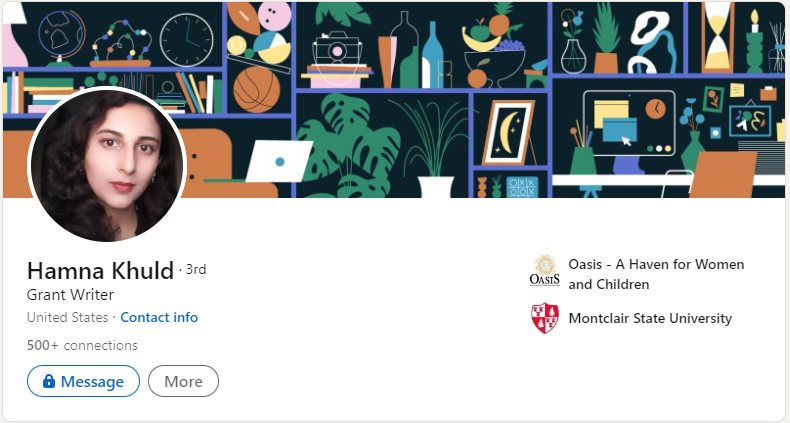
Be Smart With Your Profile Headline
A professional headline is important on LinkedIn because it is a professional summary of your experience and skills. A headline should be a clear and concise statement of who you are and what you do. It should be easy for someone to get a good sense of what you can offer. A well-written headline can make the difference between someone taking the time to read your profile or moving on to another grant writer's profile.
In today's competitive job market, you need to stand out from the crowd, and a strong headline is one way to do that. Moreover, employers and recruiters will read your headline to understand what level of services you can bring to the table.
This 220-character space limit is essential and should not be blank.
Here are some tips to optimize it:
- Add a job title in a creative manner
- Provide in one sentence who you are, what you are capable of, and how you are different from other grant writers
- Use keywords relevant to the area of specialization, such as grant writer or grant writing . This is critical because it will help you to rank your profile in search results. With no relevant keywords, employers will have a tough time finding you
- Include titles that focus on your skill set instead of unclear words, such as Superstar . For example, grant writer with four years of experience rather than Ninja grant writer Superstar .
Here is what you should not do with your headline.
- Do not write a job title
- Do not stuff it with all keywords
- Avoid calling yourself Grant Writing Enthusiast – Such a title serves no purpose
- Do not use emojis
- Do not advertise yourself looking for a job. This signals recruiters that you are a desperate person
An example of a good headline is as follows ( Jinny Jung ):
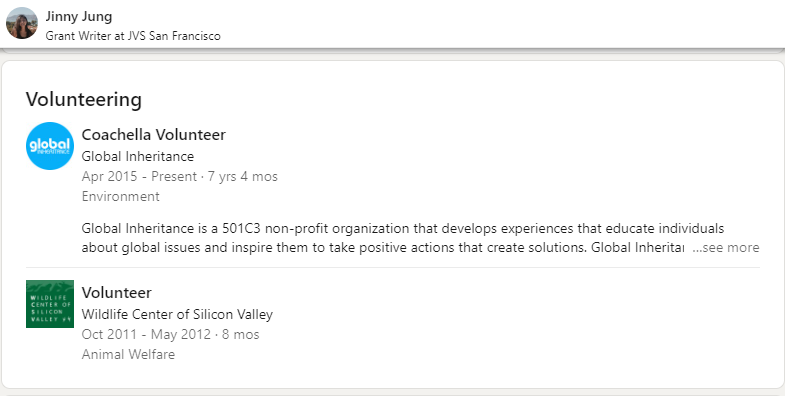
Make Getting in Touch With You Easier
When you visit someone's LinkedIn profile, you will see their URL in the search bar. For example, it could be www.linkedin.com/in/katherine-lee-3b8a40158. LinkedIn assigns this URL to every user, but there is the option to customize it. There are hundreds, if not thousands, of profiles with the same name on Linkedin. This is the primary reason why you need to have your personal website and a customized Linkedin profile URL.
LinkedIn URLs are important because they help to establish your personal brand and make it easy for people to find your profile. A customized URL can make your profile stand out from the rest and helps to build trust with potential employers or clients. It also makes it easier for people to remember your name and find you again in the future. If you have a common name, customization can give you a competitive advantage.
A customized URL is also professional and employers will take notice of this.
One way to increase your online presence is to add a personal website URL to your contact information on LinkedIn. By doing this, you are making it easy for potential employers or clients to find your website and learn more about you. Adding a personal website URL to your LinkedIn profile shows that you are proactive and committed to promoting yourself and your brand.
You can also upload a link to your resume here.
Here's how to add a link:
- Click the edit icon on the top right of your profile
- Scroll to the bottom and click Add website under the Website section
- Paste the link of your portfolio in the first field and write the text for the link in the text field
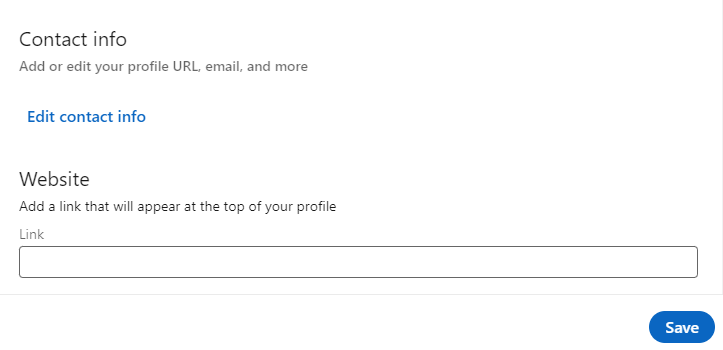
Here is what it looks like:
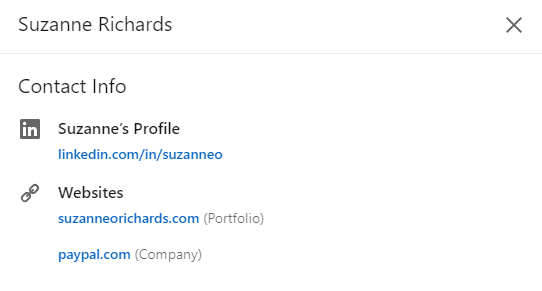
Create a Concise and Value-Driven Introduction
One of the main features of Linkedin is the ability to include an introduction about yourself. This introduction is valuable to highlight your skills and experience, and help you to stand out from the competition. However, it is important to keep your introduction concise and professional. Too much information can be overwhelming, and you don't want to come across as boastful.
Many professional grant writers leave this space blank. Do not do it with your profile. The About area is an opportunity for you to shine, so why waste it? Narrate a story about yourself, and how your grants have helped companies in securing funds. Avoid mentioning your favorite Netflix or TV shows, hobbies, and interests. Recruiters don't have time to read them, and they do not have any positive impact on your profile.
This is a 2000-character space limit to highlight yourself. Use relevant keywords to describe yourself, your previous work experience, what makes you different from others, and how you can add value in future roles. Some relevant keywords are:
- Grant writing
- Secure funds through grants
- NGO funding
- Government funding
- Grant proofread
- Managed a team of grant writers
You have to present yourself as an ambitious team player. While there is no harm in mentioning previous work accomplishments, talk about your future goals and ambitions. Employers want to know what value you can add to their companies in case they shortlist you.
Here is what this section should cover:
- An overview of who you are
- What value you can bring to the table
- Why you are different than others
- Previous accomplishments, such as the funds generated through your grants
- What you can do for potential clients
- A clear call to action (CTA)
Following is a nice example of the About section from the profile of Professional Grant Writer's CEO, Megal Hill :
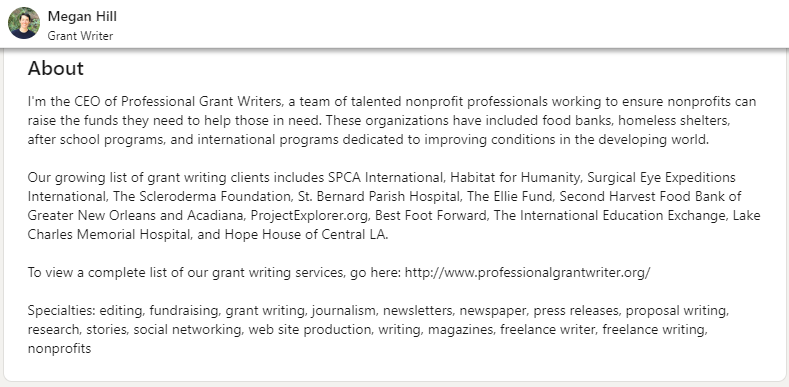
Upload a Customized Resume to Your Profile
In today's job market, competition is stiff. To stand out from the crowd, your resume must be unique to each specific job you are applying for. A customized resume shows that you have taken the time to learn about the company, and the position and that you are a serious candidate. A well-crafted resume can highlight your unique qualifications and attract a recruiter's attention. With so much at stake, it is clear that taking the time to create a customized resume for each job is an essential step in the job-search process for a grant writer.
Your LinkedIn profile and resume need to have the same details. Consider your Linkedin profile as a story of your life and your resume as a snapshot of your career.
Uploading your resume or case studies here will attract employers' attention. Here's how you can add your resume to the profile:
- Create a new post
- Click Add a document option at the bottom of the window
- Include relevant hashtags such as #grantwriter #grantwriting
Show Your Brief Work History
Your LinkedIn profile is a powerful tool that can help you connect with potential employers, customers, and business partners. And while it's important to populate your profile with key information about your skills and qualifications, the experience section is where you have a chance to shine. Here are a few tips to help you make the most of this valuable real estate:
- Start with your current or most recent position and work backward. Include the company name, your job title, and dates of employment
- For each position, include a brief synopsis of your responsibilities and accomplishments. Use bullet points to make this information easy to skim
- If you have a lot of experience, consider grouping similar positions together (e.g. Grant Writer, XYZ Company; Team Leader, ABC Company). This will help save space and prevent your profile from becoming long
- Add the Location – Enter the location of your company
- Define the Time Period – Mention the time duration (starting and ending time)
- Attach Media – Attach media such as audio, video, PDF files, Docs and Powerpoint presentations to complement your grant writer profile
Employers, recruiters, and hiring managers focus on this section to find out about your past job roles.
Here are a few tips to help you in optimizing this section:
- Keep work experience short
- It should not look different than your resume
- Do not add jobs irrelevant to your work history
- Proofread and publish
The Experience section on the LinkedIn profile should look like this:
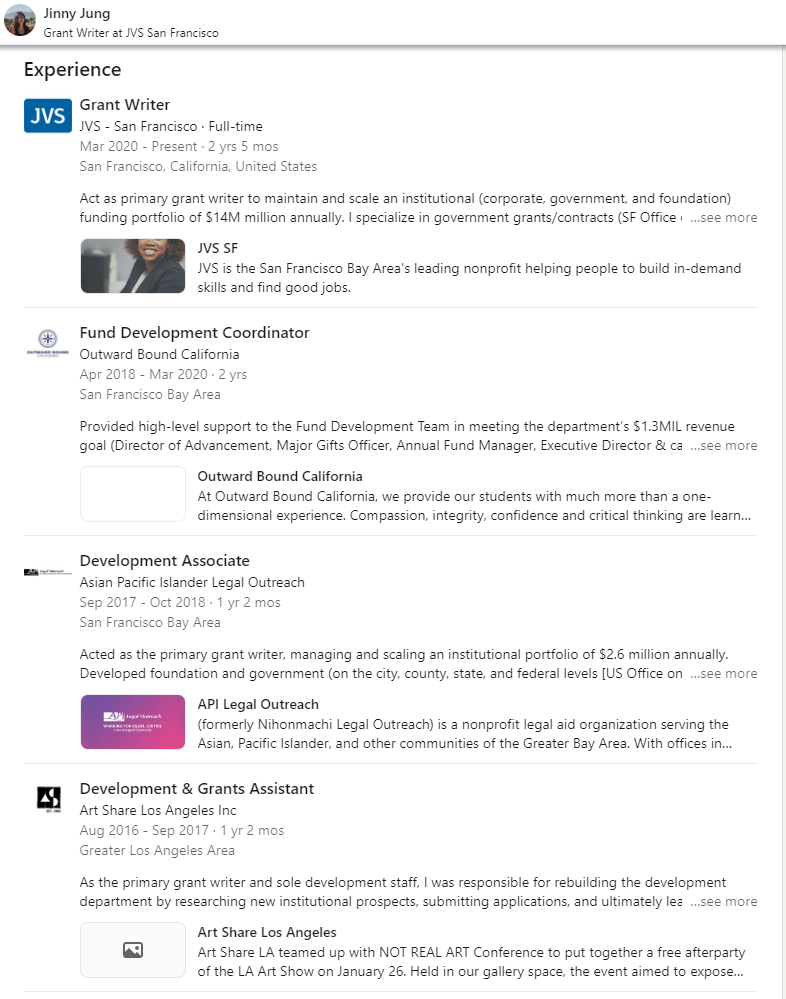
Mention Your Education and Skills
When it comes to your education and skills, include relevant information that would be of interest to potential employers. Listing education details on LinkedIn is no different than listing education on your resume.
While your overall work experience and skills matter the most in the grant writing industry, a background in education is also important.
Becoming a grant writer requires at least a bachelor's degree in English, communications or journalism, although some employers may prefer candidates with a master's degree or higher. In terms of qualifications, grant writers should have excellent research, writing, and editing skills. They should work under tight deadlines and meet their targets. Furthermore, grant writers are well-organized and detail-oriented. However, it is not essential to have a degree in one of these fields. Grant writers can come from a variety of academic backgrounds. What is most important is that they have strong writing skills and are familiar with the process of writing grants.
There are three different ways to showcase your education on Linkedin:
- General education about your college or university degree
- Certifications that you have taken offline or online
- Courses that you have taken offline or online on platforms such as Udemy and Linkedin learning
It is nice to mention your GPA, but not important. There is now less emphasis on GPAs and more on a candidate's ability to do excellent work. Also add in relevant achievements, awards, and projects that you've worked on during your studies.
Here is what the Education section on LinkedIn should look like:
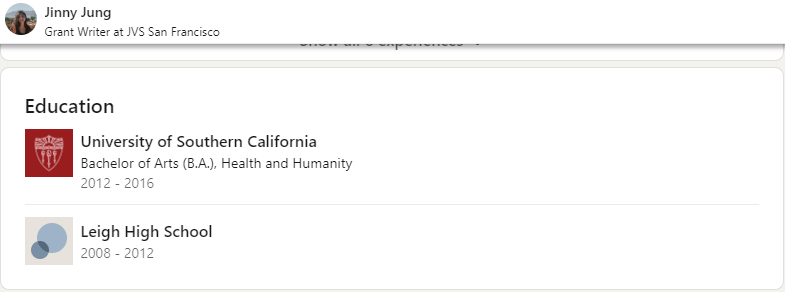
Certifications add credibility and authority to your Linkedin profile. It shows employers you have taken the necessary time to hone your skills and improve your craft as a grant writer.
For a grant writer, there are many certifications that you can take. Here are some certifications that you can take to master your skill:
- Grant Writing Certifications – Technical Writer HQ
- University of South Carolina
- Advanced Grant Writing Certification – Ed2go
- Fundamentals of Grant Writing – University of Georgia
The following list of licenses and certifications gives a good impression of the grant writer:
Adding Volunteer experience on Linkedin is a great way to stand out from the crowd. As a grant writer, volunteer experience can be a valuable asset. Recruiters look for applicants who have a commitment to their cause. By adding volunteer experience to your LinkedIn profile, you can show potential employers that you give back to the community to make a difference.
Whether you're looking for a new job or seeking funding for your nonprofit, LinkedIn is a great place to showcase your volunteer work.
You can also ask people in your network to endorse you for your skills.
The following example shows the best way to put your volunteer experiences and skills on your LinkedIn profile:
Broadcast Your Location
One of the most important pieces of information on your profile is your location. Providing an accurate location helps LinkedIn's algorithm surface your profile when people are searching for someone with your skills in their area.
Many businesses use LinkedIn filters to find candidates for open positions, and if your location isn't accurate, you may not get found.
List yourself in or nearby a city where you like to work right under your name.
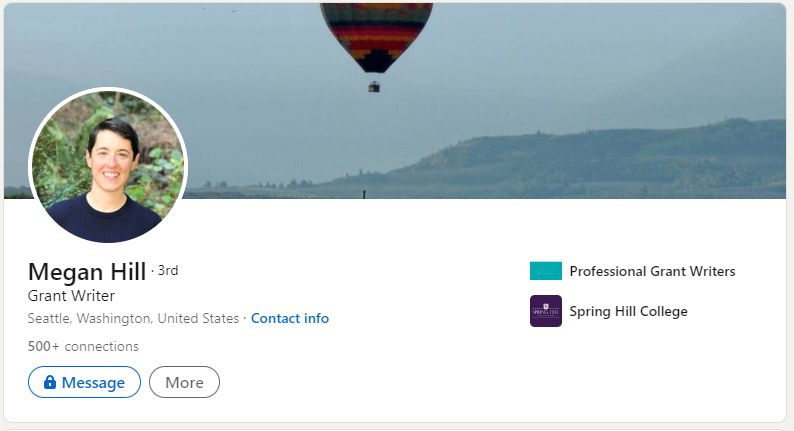
Request Recommendations From Connections
While your resume is a great summary of your qualifications, it can't speak to your character or work ethic. This is where LinkedIn recommendations come in. By requesting recommendations from others on LinkedIn, you can give potential employers a snapshot of what it's like to work with you.
Whether it's a current or former boss, colleague, or client, anyone who can attest to your skills and abilities will help you stand out from the competition. Keep in mind that LinkedIn recommendations should be specific and tailored to the role you're applying for. With a few well-chosen recommendations, you can give your LinkedIn profile the boost it needs to help you land your dream job.
Following is a great example of recommendations from the grant writer at Megan Hills' LinkedIn profile:
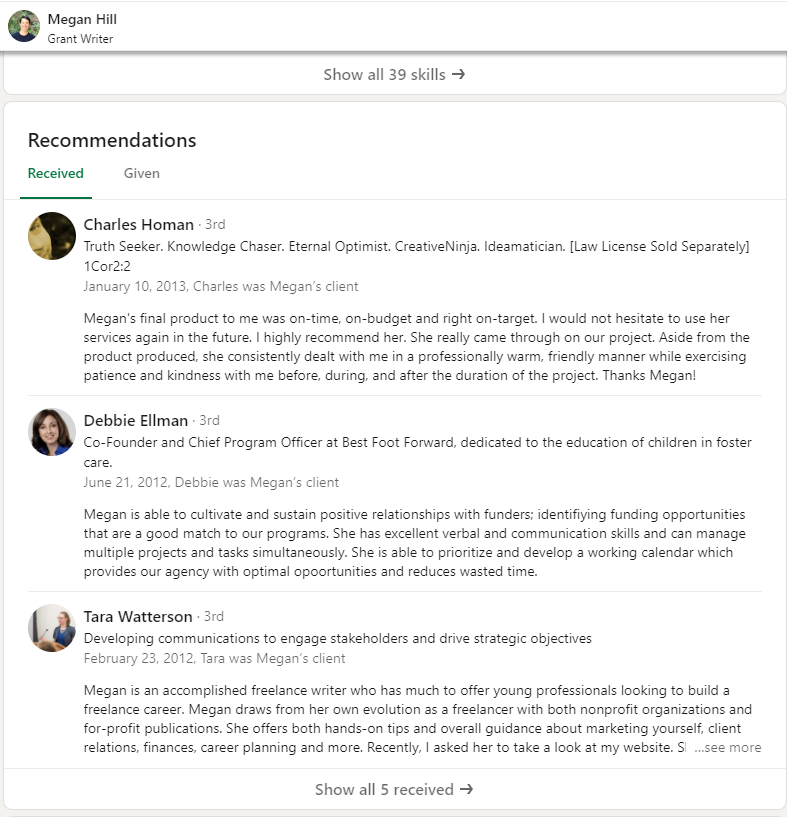
There are two ways to get recommendations:
- You can send a request to a LinkedIn contact and ask them for a recommendation
- Write a recommendation to an acquaintance and ask them to write one for you
When recruiters see that other professionals have vouched for you, employers will consider this before shortlisting you.
Use the Creator Mode
LinkedIn's Creator Mode is a new way for users to share their original content on the platform. The goal of Creator Mode is to help members better connect with professional communities and share insights in more thoughtful and authentic ways.
When you enable Creator Mode, your profile will reflect that you're an "original content creator." This designation will appear on your profile and will be visible to other LinkedIn members. LinkedIn will provide you with tools and resources to help you create and share your content. You can create content in the shape of videos, articles, blog posts, and by commenting on others' posts.
Creator Mode can help you reach a larger audience. If you're looking for a new way to share your original content, Creator Mode is worth checking out.
It also helps you in developing your personal brand on Linkedin, which is a great way to differentiate yourself from other grant writers.
Here is what this feature does:
- It changes the Connect button on your profile to Follow
- It lists the number of followers on your profile, along with topics (hashtags) you post
- It highlights the posts to help you prioritize showcasing your content over work experience
- It gives access to the LinkedIn Live feature
- It unlocks the newsletter feature, which means whenever you publish a LinkedIn article, subscribers receive push and email notifications.
Here is how this works in the following example:
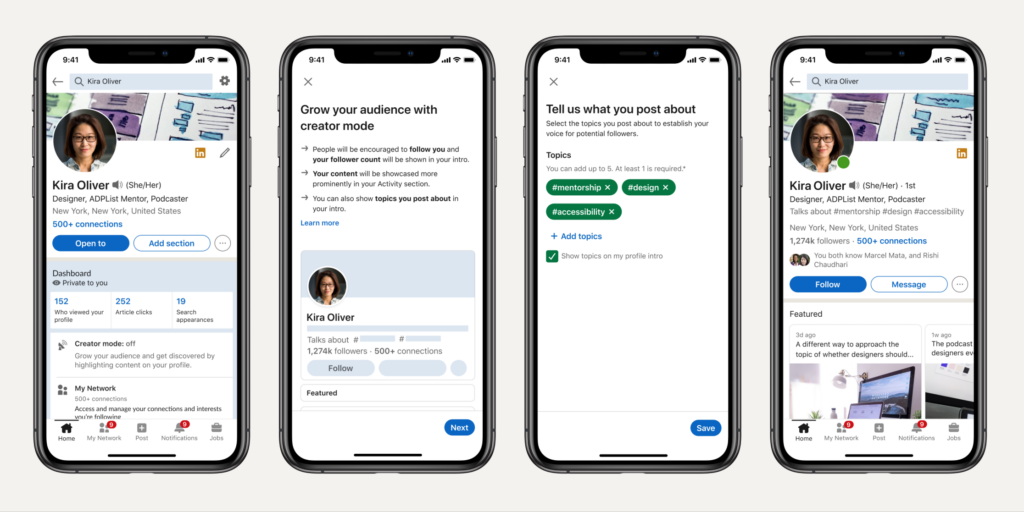
Showcase Your CTAs and Portfolio in the Featured Section
As in the screenshot of Melissa's profile above, you can add a featured section to showcase your portfolio links such as a sample UX microcopy, resume, a consultation link, and other resources to help you stand out. To add a link or work samples in the Featured section on your profile.
- Tap your profile photo from the homepage, then View Profile
- Tap Add section
- Tap Recommended and select Add featured from the dropdown
- Select the type of work sample you'd like to feature
- Tap Save or Done
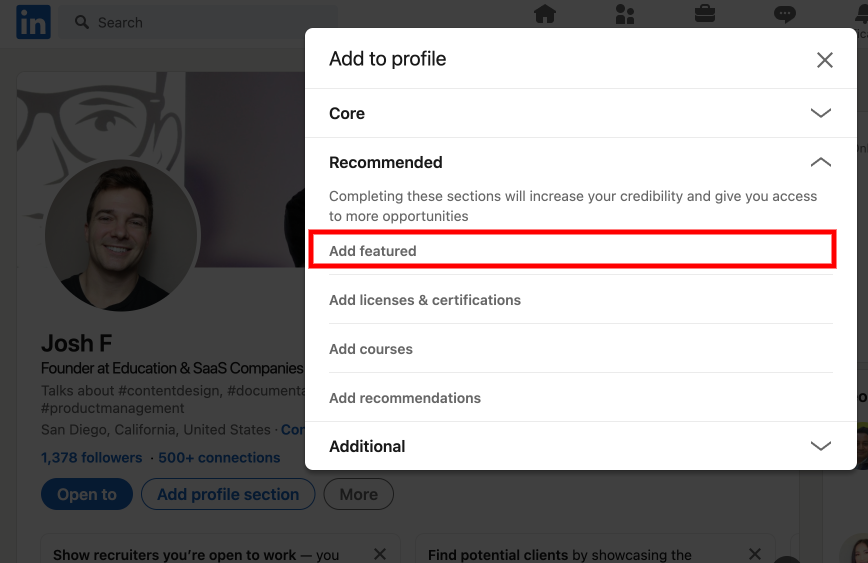
On my LinkedIn profile, I went ahead and added several of the certifications that Technical Writer HQ provides. This way if someone clicks on any of these featured links, they get taken right to the certification pages on Technical Writer HQ to sign up for the course.
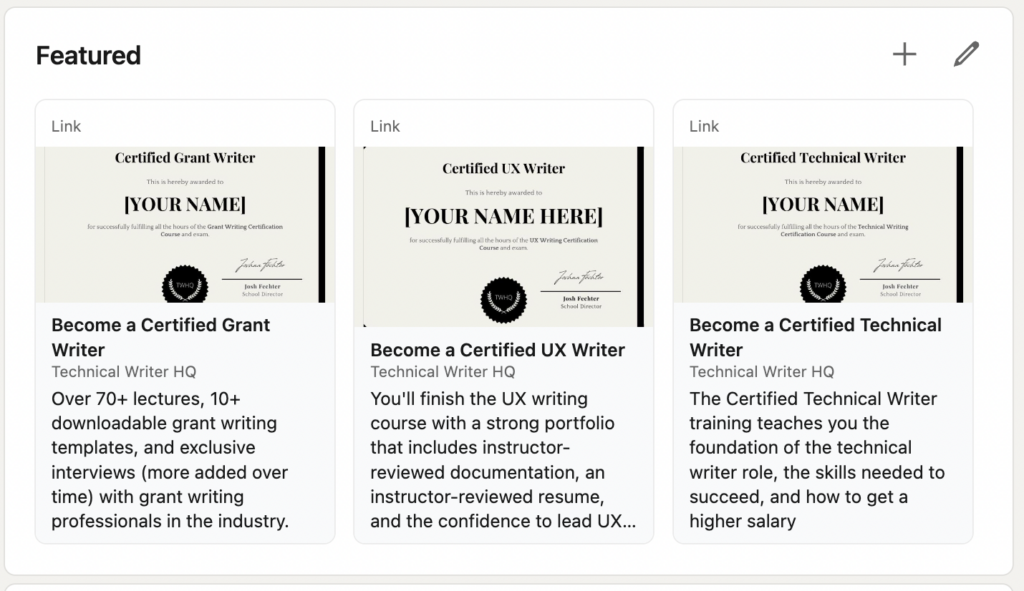
Narrow down the persona who you need to get in touch with and provide the links here that will make that happen by showcasing your value.
Closing Thoughts
LinkedIn is a powerful platform that can help job seekers in many different ways. For example, LinkedIn allows users to connect with professionals in their field, learn about new job openings, and research companies. LinkedIn provides an opportunity for job seekers to create a professional online presence and connect with potential employers. Employers use Linkedin on a regular basis to find and hire top grant writers.
This means now is the best time to create and optimize your profile. Now that you've gone through the entire blog post, it is time to work on these tips. Good luck in your job hunt.
Source: https://technicalwriterhq.com/career/grant-writer/grant-writer-linkedin-profile/

0 Response to "Grant Apply Online Access to Your Profile in Order to Continue Linkedin"
Post a Comment